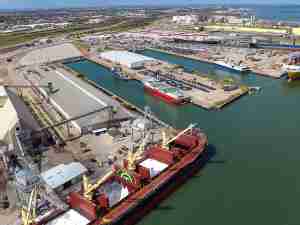Fitch Ratings has affirmed the 'A' rating on $52.86 million of revenue bonds (series 2010 and series 2014) of the Port Commission of the City and County of San Francisco (the port). The Rating Outlook is Stable.
The port also has outstanding subordinate obligations in the form of certificates of participation issued by the city, and a loan from the California Department of Boating and Waterways, neither of which are rated by Fitch.
KEY RATING DRIVERS
The rating reflects the port's low leverage and strong debt service coverage ratio (DSCR) of 9.3x, which are critical strengths given an asset base that includes significant real estate-related properties and revenues, and significant deferred maintenance and capital needs. Fitch recognizes the port's ramped-up efforts to address its aging infrastructure, with increasing but still inadequate allocations to capex from excess cash flows. Sizable portions of the capital plan remain unfunded, posing some risk to operations. Given its strategic location and relationship to the City of San Francisco (IDR AA+/Stable), the port and city are incentivised to collaboratively plan and fund necessary elements of the capital plan to maintain the asset and ensure revenue growth as well as tourist and real estate interest and safety
Strategic Location, Stable Demand - Revenue Risk (Volume): Midrange
The port's valuable real estate assets serve as a regional, national and international destination. Port properties maintained strong occupancy rates through the economic downturn and continue to demonstrate stability. This unique positioning serves to partially mitigate the port's exposure to cyclical variations in both real estate and discretionary tourism spending, as well as to competition on the maritime side of the business.
Diverse Revenue Streams - Revenue Risk (Price): Midrange
Diversity of revenue generated from real estate, parking, and maritime assets has led to a stable operating profile for the port, with non-cancellable operating leases and minimum annual guarantees providing a base level of revenue stability.
Long-Term Capital Needs Remain - Infrastructure Development and Renewal: Weaker
The port is working more aggressively to address its sizeable backlog of deferred maintenance needs. Fitch notes the nature of the capital plan prioritizes revenue generating assets, identifying non-revenue generating assets that could be shut down if needed, thereby reducing capital needs. The port estimates that for FY 2018 - 2027 its facilities require approximately $1.5 billion to maintain a state of good repair, and $562 million for conditional seismic work. The majority of state of good repair financing currently remains unidentified, but relates to sources not critical from a revenue generating perspective.
Stable Debt Structure - Debt Structure: Stronger
The port's debt is 100% fixed rate, with stable annual debt service requirements and an adequate covenant package including a cash-funded DSRF for senior bonds. The port also utilizes COPs issued through the City of San Francisco for some of its capital needs.
Financial Profile
The port's financial profile exhibits strength, with a very strong cash position more than fully offsetting outstanding debt (resulting in negative leverage) and a high DSCR of 9.3x due to manageable annual debt carrying costs. The port has an internal policy to maintain 1.75x coverage on debt going forward, and management intends to manage coverage to 2.0x or higher. The liquidity position is healthy with $146 million of unrestricted cash, equivalent to 593 days cash on hand as of fiscal year-end (FYE) 2017.
PEER GROUP
San Diego (CA) (A+/Stable), serves as a comparable peer in terms of west coast geography, secondary port function and focus on real estate operations. Both ports benefit from a strong cash position that results in negative leverage on a net debt-to-cash flow available for debt service basis. The Port of San Francisco has a significantly larger capital plan with unidentified funding sources for significant portions, whereas San Diego's capital needs are more limited and clearly identified, which helps San Diego in achieving a one-notch upward rating differentiation.
RATING SENSITIVITIES
Future Developments That May, Individually or Collectively, Lead to Negative Rating Action:
--A sustained increase in leverage or diminishment of coverage ratios, given the port's significant capital needs for state of good repair and enhancement;
--Deterioration in the health of the San Francisco economy, including the real estate market and discretionary tourism spending.
Future Developments That May, Individually or Collectively, Lead to Positive Rating Action:
--Given the port's capital condition and operating profile, positive rating migration is unlikely at this time.
CREDIT UPDATE
Performance Update
In 2017, the Port's strong financial position improved modestly despite slightly more volatile operations than recent years. Unrestricted cash grew to a robust $146 million, more than offsetting the entire balance of both revenue bonds and COPs of approximately $87 million and resulting in negative leverage on a net debt-to-cash flow available for debt service basis. The Port's manageable debt carrying costs resulted in strong 9.3x coverage of senior debt service in FY17, with estimated 5.4x total coverage including subordinate obligations.
Total operating revenues increased by 14% in FY2017 to $113.4 million, aided by modest growth in core business lines including real estate and asset management ($83.1 million) and maritime revenues ($26.0 million). The port received approximately $10 million of non-recurring operating revenues in FY2017, including proceeds from land sales and settlements from the prior operator at the Pier 70 dry dock. During FY17, the former ship repair operator abandoned the lease, which will reduce ship repair revenues from $1.4 million in FY2017 to $0 for FY2018 as the port seeks a new tenant. The port also had one-time spending in FY2017 on new accounting software and professional services consulting fees related to capital projects. These one-time sources resulted in both operating revenues and operating expenses (on an indenture basis, which excludes non-cash items such as pension expense) coming in 14% higher than FY2016 levels. The port maintains a favorable trend of operating revenue growth, at a five-year CAGR of 8.1%, compared to the operating expense five-year CAGR of 4.7%.
The port continues to address its sizable capital backlog by designating at least 20% of operating revenues to capital needs, which will help address some of the deferred maintenance needs of the port's aging infrastructure. To maximize capital designations, management plans to control operating expenditures and invest in capital projects that increase the revenue base. Management also intends to deploy a portion of the accumulated cash balances towards capital projects in each future year, which is reflected in Fitch's cases.
The port's 10-year capital plan (published biennially, covering 2018 - 2027) includes $1.5 billion of needed state of good repair, $562 million of conditional seismic work, and $733 million for capital enhancements. Also included is approximately $500 million for the initial phase of resiliency improvements to the San Francisco seawall. The seawall project is a multi-stakeholder project that includes the City of San Francisco. The port expects to leverage external financing (including a potential City GO bond issue) for this project.
In general, Fitch expects the port management to prudently allocate its internal funding to the more essential state of good repair needs while strategically analyzing revenue-generating projects. Fitch expects the port will look to create partnerships and leverage various funding and financing options to address the significant capital backlog, including tax increment and special assessment funding on new real estate projects. The port's desirable location is a key element driving long-term essentiality and demand. Fitch will continue to monitor the port's ability to prioritize state of good repair and capital enhancement work and ability to identify funding. Longer term, failure to address deferred maintenance requirements may negatively impact the port's revenue base and underlying credit quality.
Fitch Cases
Fitch's base case projects average annual revenue growth of 0.7%, slightly below the previous growth rates due to elevated revenues in FY17 relative to expectations. The base case generally tracks the port's budgeted expectations going forward, including modest increases to commercial and industrial rents, a loss of ship repair revenue through FY2020, and an increase in commercial rent in FY2020 offset by a decline in parking revenue in that year. The base case also assumes one-time asset sales of $15 million materialize in FY19 and FY20 as per the port's projections. Operating expenses are projected to increase at an average annual rate of 2%. Under this scenario, DSCR is expected to remain strong, averaging 8.7x on the senior lien and 5.1x including subordinate obligations. Leverage remains negative through FY2022 despite assuming a gradual drawdown of the port's unrestricted cash.
Under Fitch's rating case, recessionary declines are contemplated in conservative cruise and commercial real estate revenue growth, and higher operating expenses are assumed. The one-time asset sales are reduced by 50% in each year. Under this scenario, senior DSCR averages 6.0x and total DSCR averages 3.5x, while leverage also remains negative, similar to the base case.
SECURITY
The bonds are special, limited obligations of the port payable from a senior lien on net revenues of the port and from amounts on deposit in certain funds and accounts held under the indenture.










